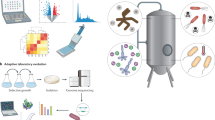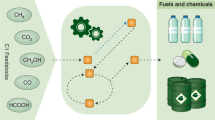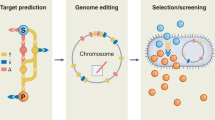Abstract
Growing concerns over limited fossil resources and associated environmental problems are motivating the development of sustainable processes for the production of chemicals, fuels and materials from renewable resources. Metabolic engineering is a key enabling technology for transforming microorganisms into efficient cell factories for these compounds. Systems metabolic engineering, which incorporates the concepts and techniques of systems biology, synthetic biology and evolutionary engineering at the systems level, offers a conceptual and technological framework to speed the creation of new metabolic enzymes and pathways or the modification of existing pathways for the optimal production of desired products. Here we discuss the general strategies of systems metabolic engineering and examples of its application and offer insights as to when and how each of the different strategies should be used. Finally, we highlight the limitations and challenges to be overcome for the systems metabolic engineering of microorganisms at more advanced levels.
This is a preview of subscription content, access via your institution
Access options
Subscribe to this journal
Receive 12 print issues and online access
$259.00 per year
only $21.58 per issue
Buy this article
- Purchase on Springer Link
- Instant access to full article PDF
Prices may be subject to local taxes which are calculated during checkout







Similar content being viewed by others
References
Na, D., Kim, T.Y. & Lee, S.Y. Construction and optimization of synthetic pathways in metabolic engineering. Curr. Opin. Microbiol. 13, 363–370 (2010).
Prather, K.L. & Martin, C.H. De novo biosynthetic pathways: rational design of microbial chemical factories. Curr. Opin. Biotechnol. 19, 468–474 (2008).
Lee, J.W., Kim, T.Y., Jang, Y.S., Choi, S. & Lee, S.Y. Systems metabolic engineering for chemicals and materials. Trends Biotechnol. 29, 370–378 (2011).
Medema, M.H., van Raaphorst, R., Takano, E. & Breitling, R. Computational tools for the synthetic design of biochemical pathways. Nat. Rev. Microbiol. 10, 191–202 (2012).
Steen, E.J. et al. Microbial production of fatty-acid–derived fuels and chemicals from plant biomass. Nature 463, 559–562 (2010).
Zhao, Y. et al. Biosynthesis of isoprene in Escherichia coli via methylerythritol phosphate (MEP) pathway. Appl. Microbiol. Biotechnol. 90, 1915–1922 (2011).
Lindberg, P., Park, S. & Melis, A. Engineering a platform for photosynthetic isoprene production in cyanobacteria, using Synechocystis as the model organism. Metab. Eng. 12, 70–79 (2010).
Atsumi, S., Hanai, T. & Liao, J.C. Non-fermentative pathways for synthesis of branched-chain higher alcohols as biofuels. Nature 451, 86–89 (2008).
McKenna, R. & Nielsen, D.R. Styrene biosynthesis from glucose by engineered E. coli. Metab. Eng. 13, 544–554 (2011).
Yim, H. et al. Metabolic engineering of Escherichia coli for direct production of 1,4-butanediol. Nat. Chem. Biol. 7, 445–452 (2011). This publication describes a combination of the pathway prediction method—focused on chemical transformations—with other engineering strategies for the production of non-natural 1,4-BDO.
Cho, A., Yun, H., Park, J., Lee, S. & Park, S. Prediction of novel synthetic pathways for the production of desired chemicals. BMC Syst. Biol. 4, 35 (2010). This study reports development of a prediction tool for evaluating new synthetic pathways for the production of alcohols, 3-hydroxypropanoate and butyryl-CoA.
Feldman, H.J., Dumontier, M., Ling, S., Haider, N. & Hogue, C.W.C.O. A chemical ontology for identification of functional groups and semantic comparison of small molecules. FEBS Lett. 579, 4685–4691 (2005).
McShan, D.C., Rao, S. & Shah, I. PathMiner: predicting metabolic pathways by heuristic search. Bioinformatics 19, 1692–1698 (2003).
McShan, D.C. & Shah, I. Heuristic search for metabolic engineering: de novo synthesis of vanillin. Comput. Chem. Eng. 29, 499–507 (2005).
Moriya, Y. et al. PathPred: an enzyme-catalyzed metabolic pathway prediction server. Nucleic Acids Res. 38, W138–W143 (2010).
Henry, C.S., Broadbelt, L.J. & Hatzimanikatis, V. Discovery and analysis of novel metabolic pathways for the biosynthesis of industrial chemicals: 3-hydroxypropanoate. Biotechnol. Bioeng. 106, 462–473 (2010).
Hatzimanikatis, V. et al. Exploring the diversity of complex metabolic networks. Bioinformatics 21, 1603–1609 (2005).
Finley, S.D., Broadbelt, L.J. & Hatzimanikatis, V. Computational framework for predictive biodegradation. Biotechnol. Bioeng. 104, 1086–1097 (2009).
Klamt, S. & Stelling, J. Two approaches for metabolic pathway analysis? Trends Biotechnol. 21, 64–69 (2003).
Burgard, A.P., Pharkya, P. & Maranas, C.D. Optknock: a bilevel programming framework for identifying gene knockout strategies for microbial strain optimization. Biotechnol. Bioeng. 84, 647–657 (2003).
Pharkya, P., Burgard, A.P. & Maranas, C.D. OptStrain: a computational framework for redesign of microbial production systems. Genome Res. 14, 2367–2376 (2004).
Jung, Y.K., Kim, T.Y., Park, S.J. & Lee, S.Y. Metabolic engineering of Escherichia coli for the production of polylactic acid and its copolymers. Biotechnol. Bioeng. 105, 161–171 (2010).
Tantillo, D.J., Chen, J. & Houk, K.N. Theozymes and compuzymes: theoretical models for biological catalysis. Curr. Opin. Chem. Biol. 2, 743–750 (1998).
Röthlisberger, D. et al. Kemp elimination catalysts by computational enzyme design. Nature 453, 190–195 (2008).
Siegel, J.B. et al. Computational design of an enzyme catalyst for a stereoselective bimolecular Diels-Alder reaction. Science 329, 309–313 (2010).
Jiang, L. et al. De novo computational design of retro-aldol enzymes. Science 319, 1387–1391 (2008).
Richter, F., Leaver-Fay, A., Khare, S.D., Bjelic, S. & Baker, D. De novo enzyme design using Rosetta3. PLoS ONE 6, e19230 (2011). This paper describes the Rosetta de novo enzyme design protocol, using triose phosphate isomerase as an example of enzyme design.
Eiteman, M.A., Lee, S.A. & Altman, E. A co-fermentation strategy to consume sugar mixtures effectively. J. Biol. Eng. 2, 3 (2008).
Ren, C., Chen, T., Zhang, J., Liang, L. & Lin, Z. An evolved xylose transporter from Zymomonas mobilis enhances sugar transport in Escherichia coli. Microb. Cell Fact. 8, 66 (2009).
Lindner, S.N., Seibold, G.M., Henrich, A., Kramer, R. & Wendisch, V.F. Phosphotransferase system-independent glucose utilization in Corynebacterium glutamicum by inositol permeases and glucokinases. Appl. Environ. Microbiol. 77, 3571–3581 (2011).
Lee, K.H., Park, J.H., Kim, T.Y., Kim, H.U. & Lee, S.Y. Systems metabolic engineering of Escherichia coli for L-threonine production. Mol. Syst. Biol. 3, 149 (2007).
Park, J.H., Lee, K.H., Kim, T.Y. & Lee, S.Y. Metabolic engineering of Escherichia coli for the production of L-valine based on transcriptome analysis and in silico gene knockout simulation. Proc. Natl. Acad. Sci. USA 104, 7797–7802 (2007).
Qian, Z.G., Xia, X.X. & Lee, S.Y. Metabolic engineering of Escherichia coli for the production of putrescine: a four carbon diamine. Biotechnol. Bioeng. 104, 651–662 (2009).
Qian, Z.G., Xia, X.X. & Lee, S.Y. Metabolic engineering of Escherichia coli for the production of cadaverine: a five carbon diamine. Biotechnol. Bioeng. 108, 93–103 (2011).
Dunlop, M.J. et al. Engineering microbial biofuel tolerance and export using efflux pumps. Mol. Syst. Biol. 7, 487 (2011).
Shen, C.R. et al. Driving forces enable high-titer anaerobic 1-butanol synthesis in Escherichia coli. Appl. Environ. Microbiol. 77, 2905–2915 (2011).
Dellomonaco, C., Clomburg, J.M., Miller, E.N. & Gonzalez, R. Engineered reversal of the β-oxidation cycle for the synthesis of fuels and chemicals. Nature 476, 355–359 (2011). An excellent example of metabolic engineering, incorporating disarmament of transcriptional regulation and enzyme screening for the production of aliphatic alcohols and acids, especially n -butanol.
Auriol, C., Bestel-Corre, G., Claude, J.B., Soucaille, P. & Meynial-Salles, I. Stress-induced evolution of Escherichia coli points to original concepts in respiratory cofactor selectivity. Proc. Natl. Acad. Sci. USA 108, 1278–1283 (2011).
Charusanti, P. et al. Genetic basis of growth adaptation of Escherichia coli after deletion of pgi, a major metabolic gene. PLoS Genet. 6, e1001186 (2010).
Chemler, J.A., Fowler, Z.L., McHugh, K.P. & Koffas, M.A.G. Improving NADPH availability for natural product biosynthesis in Escherichia coli by metabolic engineering. Metab. Eng. 12, 96–104 (2010).
Martínez, I., Zhu, J., Lin, H., Bennett, G.N. & San, K.Y. Replacing Escherichia coli NAD-dependent glyceraldehyde 3-phosphate dehydrogenase (GAPDH) with a NADP-dependent enzyme from Clostridium acetobutylicum facilitates NADPH dependent pathways. Metab. Eng. 10, 352–359 (2008).
Ma, S.M. et al. Optimization of a heterologous mevalonate pathway through the use of variant HMG-CoA reductases. Metab. Eng. 13, 588–597 (2011).
Bastian, S. et al. Engineered ketol-acid reductoisomerase and alcohol dehydrogenase enable anaerobic 2-methylpropan-1-ol production at theoretical yield in Escherichia coli. Metab. Eng. 13, 345–352 (2011).
Ehsani, M., Fernandez, M.R., Biosca, J.A. & Dequin, S. Reversal of coenzyme specificity of 2,3-butanediol dehydrogenase from Saccharomyces cerevisae and in vivo functional analysis. Biotechnol. Bioeng. 104, 381–389 (2009).
Palsson, B. & Zengler, K. The challenges of integrating multi-omic data sets. Nat. Chem. Biol. 6, 787–789 (2010).
Park, J.M., Kim, T.Y. & Lee, S.Y. Constraints-based genome-scale metabolic simulation for systems metabolic engineering. Biotechnol. Adv. 27, 979–988 (2009).
Lee, S.J., Song, H. & Lee, S.Y. Genome-based metabolic engineering of Mannheimia succiniciproducens for succinic acid production. Appl. Environ. Microbiol. 72, 1939–1948 (2006).
Atsumi, S. et al. Evolution, genomic analysis, and reconstruction of isobutanol tolerance in Escherichia coli. Mol. Syst. Biol. 6, 449 (2010).
Becker, J., Zelder, O., Hafner, S., Schroder, H. & Wittmann, C. From zero to hero—design-based systems metabolic engineering of Corynebacterium glutamicum for L-lysine production. Metab. Eng. 13, 159–168 (2011).
Na, D., Lee, S. & Lee, D. Mathematical modeling of translation initiation for the estimation of its efficiency to computationally design mRNA sequences with a desired expression level in prokaryotes. BMC Syst. Biol. 4, 71 (2010).
Salis, H.M., Mirsky, E.A. & Voigt, C.A. Automated design of synthetic ribosome binding sites to control protein expression. Nat. Biotechnol. 27, 946–950 (2009).
Solomon, K.V. & Prather, K.L. The zero-sum game of pathway optimization: emerging paradigms for tuning gene expression. Biotechnol. J. 6, 1064–1070 (2011).
Jantama, K. et al. Combining metabolic engineering and metabolic evolution to develop nonrecombinant strains of Escherichia coli C that produce succinate and malate. Biotechnol. Bioeng. 99, 1140–1153 (2008).
Leonard, E. et al. Combining metabolic and protein engineering of a terpenoid biosynthetic pathway for overproduction and selectivity control. Proc. Natl. Acad. Sci. USA 107, 13654–13659 (2010). This study optimizes geranylgeranyl diphosphate synthase and levopimaradiene synthase by enzyme evolution and active site mutations, respectively, for the overproduction of levopimaradiene in E. coli.
Wang, H.H. et al. Programming cells by multiplex genome engineering and accelerated evolution. Nature 460, 894–898 (2009).
Orth, J.D., Thiele, I. & Palsson, B.O. What is flux balance analysis? Nat. Biotechnol. 28, 245–248 (2010).
Thiele, I. & Palsson, B.O. A protocol for generating a high-quality genome-scale metabolic reconstruction. Nat. Protoc. 5, 93–121 (2010).
Shlomi, T., Eisenberg, Y., Sharan, R. & Ruppin, E. A genome-scale computational study of the interplay between transcriptional regulation and metabolism. Mol. Syst. Biol. 3, 101 (2007).
Henry, C.S., Broadbelt, L.J. & Hatzimanikatis, V. Thermodynamics-based metabolic flux analysis. Biophys. J. 92, 1792–1805 (2007).
Park, J.M., Kim, T.Y. & Lee, S.Y. Prediction of metabolic fluxes by incorporating genomic context and flux-converging pattern analyses. Proc. Natl. Acad. Sci. USA 107, 14931–14936 (2010).
Chandrasekaran, S. & Price, N.D. Probabilistic integrative modeling of genome-scale metabolic and regulatory networks in Escherichia coli and Mycobacterium tuberculosis. Proc. Natl. Acad. Sci. USA 107, 17845–17850 (2010).
Zhuang, K., Vemuri, G.N. & Mahadevan, R. Economics of membrane occupancy and respiro-fermentation. Mol. Syst. Biol. 7, 500 (2011).
Segrè, D., Vitkup, D. & Church, G.M. Analysis of optimality in natural and perturbed metabolic networks. Proc. Natl. Acad. Sci. USA 99, 15112–15117 (2002).
Lun, D.S. et al. Large-scale identification of genetic design strategies using local search. Mol. Syst. Biol. 5, 296 (2009).
Ranganathan, S., Suthers, P.F. & Maranas, C.D. OptForce: an optimization procedure for identifying all genetic manipulations leading to targeted overproductions. PLoS Comput. Biol. 6, e1000744 (2010).
Kim, J. & Reed, J.L. OptORF: optimal metabolic and regulatory perturbations for metabolic engineering of microbial strains. BMC Syst. Biol. 4, 53 (2010).
Choi, H.S., Lee, S.Y., Kim, T.Y. & Woo, H.M. In silico identification of gene amplification targets for improvement of lycopene production. Appl. Environ. Microbiol. 76, 3097–3105 (2010).
Yang, L., Cluett, W.R. & Mahadevan, R. EMILiO: a fast algorithm for genome-scale strain design. Metab. Eng. 13, 272–281 (2011).
Asadollahi, M.A. et al. Enhancing sesquiterpene production in Saccharomyces cerevisiae through in silico driven metabolic engineering. Metab. Eng. 11, 328–334 (2009).
Burk, M.J., Burgard, A., Osterhout, R.E. & Pharkya, P. Microorganisms and methods for the biosynthesis of adipate, hexamethylenediamine and 6-aminocaproic acid. US Patent 0317069 (2010)
Kizer, L., Pitera, D.J., Pfleger, B.F. & Keasling, J.D. Application of functional genomics to pathway optimization for increased isoprenoid production. Appl. Environ. Microbiol. 74, 3229–3241 (2008).
Ajikumar, P.K. et al. Isoprenoid pathway optimization for taxol precursor overproduction in Escherichia coli. Science 330, 70–74 (2010). A multivariate-modular approach for optimizing metabolic fluxes via the methylerythritol-phosphate and terpenoid-forming pathways for enhanced production of a taxol precursor.
Noirel, J., Ow, S.Y., Sanguinetti, G. & Wright, P.C. Systems biology meets synthetic biology: a case study of the metabolic effects of synthetic rewiring. Mol. Biosyst. 5, 1214–1223 (2009).
Zhang, F., Carothers, J.M. & Keasling, J.D. Design of a dynamic sensor-regulator system for production of chemicals and fuels derived from fatty acids. Nat. Biotechnol. 30, 354–359 (2012).
Carothers, J.M., Goler, J.A., Juminaga, D. & Keasling, J.D. Model-driven engineering of RNA devices to quantitatively program gene expression. Science 334, 1716–1719 (2011).
Dueber, J.E. et al. Synthetic protein scaffolds provide modular control over metabolic flux. Nat. Biotechnol. 27, 753–759 (2009). A protein-scaffold strategy that mimics natural substrate tunneling, improving metabolite conversion efficiency by putting enzymes in close proximity.
Moon, T.S., Dueber, J.E., Shiue, E. & Prather, K.L. Use of modular, synthetic scaffolds for improved production of glucaric acid in engineered E. coli. Metab. Eng. 12, 298–305 (2010).
Jantama, K. et al. Eliminating side products and increasing succinate yields in engineered strains of Escherichia coli C. Biotechnol. Bioeng. 101, 881–893 (2008).
Zhang, X. et al. Metabolic evolution of energy-conserving pathways for succinate production in Escherichia coli. Proc. Natl. Acad. Sci. USA 106, 20180–20185 (2009).
Warner, J.R., Reeder, P.J., Karimpour-Fard, A., Woodruff, L.B. & Gill, R.T. Rapid profiling of a microbial genome using mixtures of barcoded oligonucleotides. Nat. Biotechnol. 28, 856–862 (2010).
Yang, T.H. et al. Biosynthesis of polylactic acid and its copolymers using evolved propionate CoA transferase and PHA synthase. Biotechnol. Bioeng. 105, 150–160 (2010).
Atsumi, S. et al. Metabolic engineering of Escherichia coli for 1-butanol production. Metab. Eng. 10, 305–311 (2008).
Wargacki, A.J. et al. An engineered microbial platform for direct biofuel production from brown macroalgae. Science 335, 308–313 (2012).
Nichols, N.N., Dien, B.S. & Bothast, R.J. Use of catabolite repression mutants for fermentation of sugar mixtures to ethanol. Appl. Microbiol. Biotechnol. 56, 120–125 (2001).
Becker, J., Buschke, N., Bucker, R. & Wittmann, C. Systems level engineering of Corynebacterium glutamicum: reprogramming translational efficiency for superior production. Eng. Life Sci. 10, 430–438 (2010).
Huo, Y.-X. et al. Conversion of proteins into biofuels by engineering nitrogen flux. Nat. Biotechnol. 29, 346–351 (2011).
Xia, X.X. et al. Native-sized recombinant spider silk protein produced in metabolically engineered Escherichia coli results in a strong fiber. Proc. Natl. Acad. Sci. USA 107, 14059–14063 (2010).
Lale, R. et al. Continuous control of the flow in biochemical pathways through 5′ untranslated region sequence modifications in mRNA expressed from the broad-host-range promoter Pm. Appl. Environ. Microbiol. 77, 2648–2655 (2011).
Zhang, K., Li, H., Cho, K.M. & Liao, J.C. Expanding metabolism for total biosynthesis of the non-natural amino acid L-homoalanine. Proc. Natl. Acad. Sci. USA 107, 6234–6239 (2010).
Zhang, X., Jantama, K., Moore, J.C., Shanmugam, K.T. & Ingram, L.O. Production of L-alanine by metabolically engineered Escherichia coli. Appl. Microbiol. Biotechnol. 77, 355–366 (2007).
Wierckx, N.J. et al. Transcriptome analysis of a phenol-producing Pseudomonas putida S12 construct: genetic and physiological basis for improved production. J. Bacteriol. 190, 2822–2830 (2008).
Wierckx, N.J., Ballerstedt, H., de Bont, J.A. & Wery, J. Engineering of solvent-tolerant Pseudomonas putida S12 for bioproduction of phenol from glucose. Appl. Environ. Microbiol. 71, 8221–8227 (2005).
Acknowledgements
We thank H.U. Kim for helpful discussion. This work was supported by the Advanced Biomass Research and Development Center of Korea (ABC-2010-0029799) through the Global Frontier Research Program (GFRP) of the Ministry of Education, Science and Technology (MEST) and also by the Intelligent Synthetic Biology Center (2011-0031963) through the GFRP of MEST. We also thank the World Class University program (R32-2008-000-10142-0) of MEST for additional support.
Author information
Authors and Affiliations
Corresponding author
Ethics declarations
Competing interests
The authors declare no competing financial interests.
Rights and permissions
About this article
Cite this article
Lee, J., Na, D., Park, J. et al. Systems metabolic engineering of microorganisms for natural and non-natural chemicals. Nat Chem Biol 8, 536–546 (2012). https://doi.org/10.1038/nchembio.970
Published:
Issue Date:
DOI: https://doi.org/10.1038/nchembio.970
This article is cited by
-
Use of antioxidants to extend the storage of lyophilized cell-free synthesis system
Biotechnology and Bioprocess Engineering (2024)
-
Systems metabolic engineering of Escherichia coli for hyper-production of 5‑aminolevulinic acid
Biotechnology for Biofuels and Bioproducts (2023)
-
Efficient production of cembratriene-ol in Escherichia coli via systematic optimization
Microbial Cell Factories (2023)
-
Investigating ethanol production using the Zymomonas mobilis crude extract
Scientific Reports (2023)
-
Quantitative Methods for Metabolite Analysis in Metabolic Engineering
Biotechnology and Bioprocess Engineering (2023)



